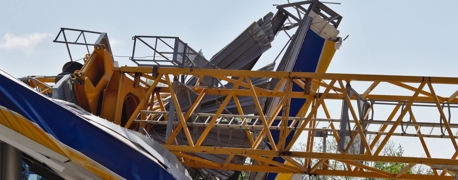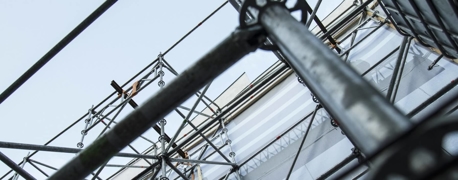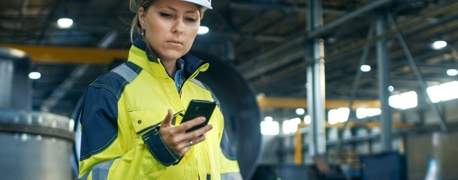Making Construction Sites Safer: How Employers Can Reduce Risks on Building Sites
.2112301649471.jpg)
According to OSHA, only about 6% of the nation’s workforce is in construction, but a whopping 20% of all worker deaths occur in this industry. This means that one in five U.S. worker deaths occur in construction. This number is not just high; it’s also highly disproportionate.
So, what makes construction such a dangerous industry?
For one thing, construction workers face inherent job-related risks that many other workers simply do not. From working with dangerous equipment to completing jobs at great heights, contractors, subcontractors, and other construction workers deal with physical challenges not commonly found in other industries. But one of the main things that makes construction so dangerous is employers’ failure to follow safety standards and regulations.
Overall, worker deaths in the United States are down, thanks in large part to the efforts of advocates like OSHA, the National Safety Council, and unions. However, despite a decrease of more than 50% in U.S. worker deaths in as many years, there’s still a lot of work to be done when it comes to improving workplace safety. This is especially true in construction, where the fatality rate remains disparately high.
Construction’s Fatal Four: The Biggest Risks to Workers
The fact remains: construction sites are dangerous places to work. From the design of the site to the equipment used, everything must be carefully coordinated to not only complete the project on time and on budget, but also, most importantly, safely. As such, it’s important for employers to take every precaution possible to ensure the safety of their workers while on site.
Unfortunately, this doesn’t always happen. Every day, construction workers across the U.S. are seriously injured or killed in tragic—and preventable—accidents. Some of these incidents are so common, OSHA has nicknamed them “the fatal four.”
The construction industry’s “fatal four” are:
- Falls
- Electrocution
- Being struck by an object
- Being caught in between objects
These dangers are called the “fatal four” because they cause approximately 60% of fatal injuries in the construction industry. Of these four hazards, falls account for 36.5% of construction industry deaths as of 2025, making it the most common cause of fatalities in this industry.
The second most common cause of construction-related fatalities is electrocution, at 8.5%, followed by struck-by hazards, at 8.4%. Caught-in or caught-between incidents lead to about 1.4% of all construction-related deaths.
The Most Common Nonfatal Injuries in Construction
Aside from the high number of fatalities that occur in the construction industry, nonfatal injuries are also a serious concern. According to OSHA, roughly 1 in 10 construction workers are injured each year, and as many as half of those incidents go unreported.
Common nonfatal injuries in construction include:
- Slips, trips, and falls
- Struck-by and caught-between injuries
- Machine entanglement
- Contact with objects and equipment
- Hearing damage or loss
- Repetitive motion injuries
- Amputation and crush injuries
- Burn injuries
- Respiratory illnesses
- Back injuries from heavy lifting
- Spinal cord injuries
- Toxic exposure
- Traumatic brain injuries
- Eye injury and vision damage
- Sprains and strains
- Overexertion injuries
- Heat exhaustion and heat stroke
- Serious bone fractures
Although these injuries are not always fatal, their impact is immense. Often, workers suffer catastrophic injuries that completely change every aspect of their lives, leading to massive medical bills, months or years of lost wages, and the inability to return to their occupations. All of this can cause considerable mental suffering, not to mention extreme physical pain and trauma.
Safety Violations: The Leading Cause of Construction Accidents
In order to prevent construction accidents, injuries, and deaths, OSHA has established several safety standards for construction worksites. These standards have made an incredible difference in the safety of construction workers over the years, but, unfortunately, many companies continue to prioritize profits over safety.
Year after year, construction remains one of—if not the—most dangerous industries for workers. The Bureau of Labor Statistics (BLS) reported that, in 2023, the construction industry saw the highest number of fatalities across all sectors with 1,075 fatalities. A little more than 39% of those fatalities were attributed to slips, trips, and falls. But the real cause of most of these incidents? Employer negligence.
When employers violate OSHA regulations, they put employees at risk. And, sadly, these violations occur all the time.
For the 2024 fiscal year, the most commonly violated OSHA standards included:
- Fall protection
- Hazard communication
- Control of hazardous energy (lockout/tagout)
- Ladders
- Respiratory protection
- Powered industrial trucks
- Fall protection training
- Scaffolding
- Eye and face protection
- Machine guarding
Considering that falls are at the top of the “fatal four” list, it should come as no surprise that so many OSHA violations involve fall protection and fall protection training. Unfortunately, this is nothing new. In fact, fall-related OSHA violations have remained the top OSHA violation for 14 years in a row.
Preventing Construction Injuries & Deaths with Risk Mitigation
Simply put, risk mitigation is the concentrated effort to reduce workplace hazards. This process begins even before a project is bid on and continues until the project is complete; safety must be considered every step of the way.
To help prevent fatal and nonfatal injuries, construction companies should adhere to the four types of risk mitigation.
The four types of risk mitigation are:
- Risk Acceptance: Although it doesn’t reduce the effects of the risk, risk acceptance is common when the cost of the risk is lower than that of safer alternatives, such as risk avoidance or limitation.
- Risk Avoidance: Often the most expensive option, risk avoidance removes any exposure to the risk.
- Risk Limitation: The most common strategy, risk limitation often combines risk acceptance and risk avoidance.
- Risk Transference: A common practice in the construction industry, risk transference involves handing risk off to a third party, such as outsourcing a job or a portion of the project.
How Can Risk Mitigation Make Construction Sites Safer?
Risk mitigation is an important aspect of keeping construction sites safe. It should be considered in every bid and plan throughout a project.
A risk mitigation plan should include:
- A list of risks
- A rating of each risk
- An assessment of current processes
- A plan of action
A plan is just the start of risk mitigation. Once team members have been identified to own a site’s risk management, they should work through this plan with each individual risk. Additionally, once these steps have been completed, the plan should be tested, and workers should be effectively trained on the correct implementation of the risk mitigation plan.
Risk Mitigation Techniques to Prevent the Fatal Four
To help prevent the “fatal four,” specifically, safety techniques must be implemented on construction sites after being assessed through the risk mitigation plan.
Some examples of these techniques include:
- The three points of contact rule to prevent falls.This rule states that three out of four limbs must be in contact with the vehicle, ladder, or platform a person is climbing or standing on to maximize stability.
- Training on equipment like cranes and aerial lifts to prevent collisions, falling objects, dropped loads, and other vehicle-related hazards.
- Improving communication amongst workers and between project managers and their teams. This is especially important for communicating hazards, as well as safety practices to avoid risks.
- Providing the proper protective equipment for the job. This includes respirators that are suitable for the required work, safety harnesses and other personal fall arrest systems, as well as eye and ear protection.
These rules should not only be taught through training but also maintained and enforced throughout the duration of the construction project. This not only helps to prepare workers for potential risks but also aids in reducing these risks to keep workers safe.


